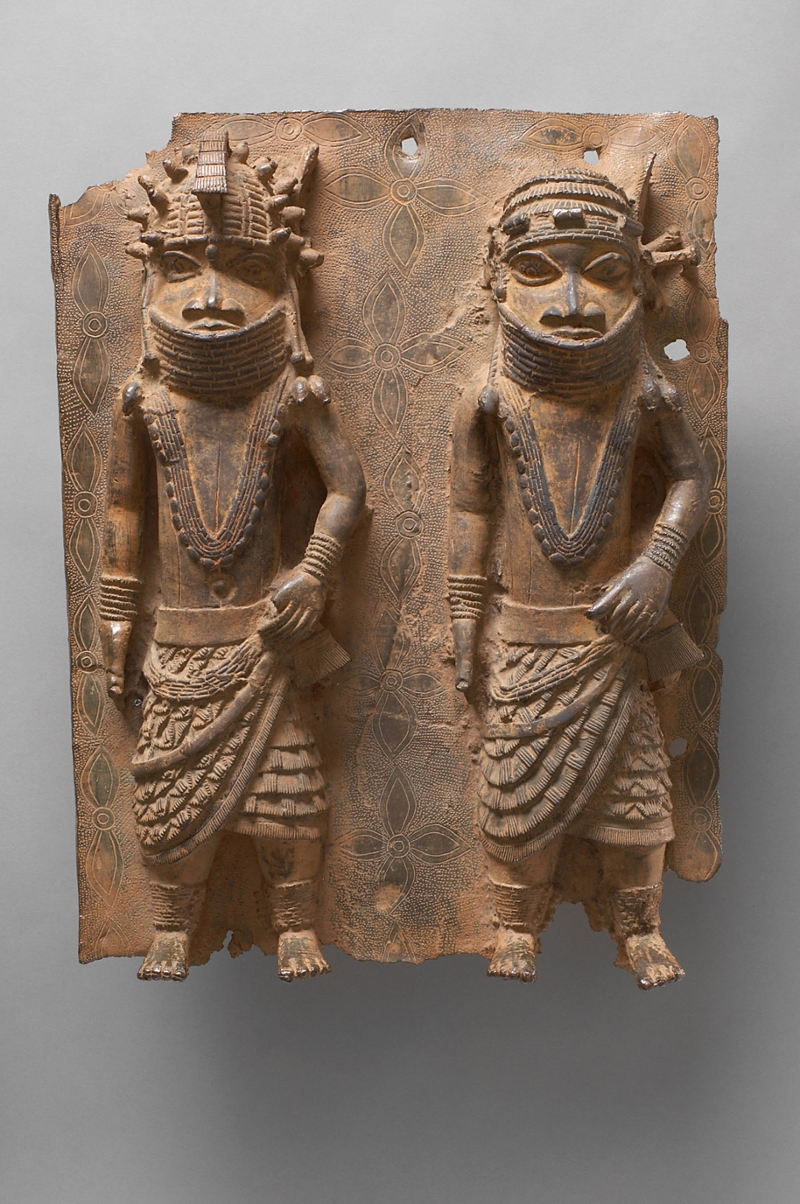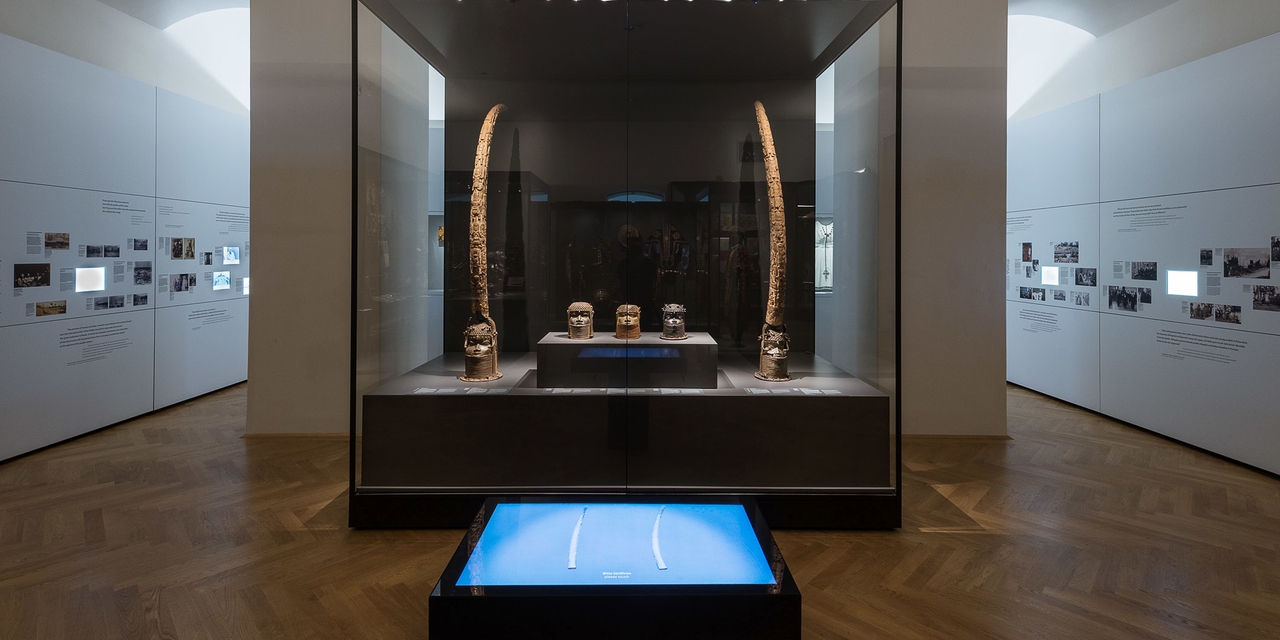By Melissa Erhardt
Almost exactly 124 years ago, in February 1897, Great Britain took the Edo-founded Kingdom of Benin in western Africa in a military operation. The reason: The Owa (King) of Benin, Ovonramwen Nogbaisi, had not adhered to the trade treaty that would have given the British economic power over the kingdom. He and his people resisted British influence by force.
As punishment, the British soldiers ransacked the palace of Owas, exiled it and brought the kingdom under British control. It was the end of independence for the Kingdom of Benin, which still exists in Nigeria today, but without political power.
The objects that were stolen from the palace – especially the valuable “Benin bronzes” and ivory carvings – ended up on the London art market that same year, where they were sold to later finance the war. Many of the objects came this way to Vienna, where they are now part of the collection in the Weltmuseum “Benin and Ethiopia: Art, Power and Resistance” to be issued. The museum is open about the history of the objects. It is precisely traced, and video clips are even shown by representatives of the Edo Kingdom in which they claim their works back. “Nothing is hidden in the museum, nothing is swept under the carpet. You can read everything, it’s there, ”says cultural mediator Stella Asiimwe in an online exhibition talk at the Weltmuseum.
KHM-Museumsverband
The two court dwarfs in the Weltmuseum Wien are unique in the world. They are among the earliest works of art from Benin (14th / 15th century)
–
Robbery of the “collective memory”
But did that end the matter? With the Edo, the descendants of the founders of the Kingdom of Benin, almost everyone knows the history of the Benin bronzes. For them, however, these are not just works of art: the Edo people did not use written language, and important events were cast in bronze or carved in ivory.
With the robbery, history, their “collective memory”, has been taken from them. Since 1914, all Obas of the Edo have therefore been demanding their objects back – without success. A small step closer to this goal has come with the Benin Dialogue Group, which has existed since 2010 and to which the Weltmuseum Wien also belongs: “The goal is to work together on this historical heritage and to think about joint possible future designs – within the framework of the Opportunities of museums ”, says Nadja Haumberger, curator of the Benin exhibition in the Weltmuseum and representative of the museum in the Benin Dialogues. Currently it has been agreed that there will be a new museum in Benin City, the so-called Edo Museum of West African Art, “And all participating institutions of the dialogue group will send loans to this museum, including us.”

KHM-Museumsverband
Relief plate: two dignitaries (brass, 16th / 17th century)
–
There is no political will
The fact that only loans and not the return of the Benin bronzes are negotiated is angry with many. The fact is: Much more is not possible at the museum level – clear political decisions would be needed for an actual restitution. Haumberger: “In Austria and in many other European institutions that also take part in this dialogue group, the museum manages these objects but does not own them. All objects in all Austrian federal museums are owned by the Republic of Austria. That makes it more difficult for us to talk about these things. “
And what does politics say about it? There has been only minimal progress in this area in Austria. According to NEOS, on their initiative, around 160,000 euros were released for provenance research in 2021 in order to start processing the around 46,000 objects of African origin in Austria. Many see this as a first important step, which is also recorded in the turquoise-green government program. Others see provenance research as just a way to buy time, as Dr. Louis Henri Seukwa, German migration researcher on a panel of the Black Voices referendum on the subject, says: “In provenance research, the rules are only once again determined by Europe. If we are to talk about a return, we need a top-level apology that Europe was involved in these colonial crimes. Only then creates the basis for a discussion. Then you need compensation, transparency and participation. “
In Austria a new law would be necessary for the return of objects. According to Vice Chancellor and Minister of Culture Werner Kogler (Greens) “due to the existence of completely different historical and legal parameters”, the Austrian Art Restitution Act, which regulates the return of art objects that were stolen in connection with National Socialism, cannot be applied to other historical contexts (such as the Benin context), as he answered a parliamentary question from NEOS in early 2020.
Not a new debate, but a new dynamic
The debate surrounding the return of looted colonial art has existed since the 1970s. A breath of fresh air in Europe only came through a report by the French art historian Bénédicte Savoy and the Senegalese scholar Felwine Sarr, commissioned by French President Emmanuel Macron, in which the return of artifacts from sub-Saharan Africa was recommended.
There has recently been a major breakthrough in the Netherlands, where the incumbent Minister of Culture Ingrid van Engelshoven has adopted a report by an advisory commission calling for a policy of “unconditional return” of objects stolen from Dutch colonies and objects from colonies in other countries weighs the interests of the parties – regardless of whether the research shows whether they were robbed or not.
Meanwhile, the 34th African Union Summit took place in Africa at the beginning of February under the leadership of the President of the Democratic Republic of the Congo, Felix Tshisekedi. Under this year’s motto “Arts, Culture and Heritage: Levers for Building the Africa We Want”, the focus is on the culture and heritage of the continent. The goal of returning looted colonial art, which was already set out in Agenda 2063 in 2015, is confirmed once again, as journalist Simon Inou also says in the Black Voices panel: “For the first time the African Union is coming with the motto: We want our things back. And that is very important. “
–


